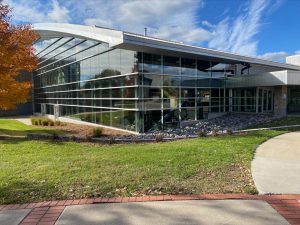Bird-window collisions grow
November 3, 2021

Frequent bird strikes are happening on campus, especially since bird migration is very high in the fall. The most common bird strikes happen at Reeve Union and the entrance windows of Sage Hall.
Bird-window collisions on campus buildings continue to be a problem at UW Oshkosh after the installation of window decals was delayed.
Student and faculty researchers recently concluded a bird-strike survey for the annual fall migration. Their findings indicate that two campus buildings are contributing to an uptick in collisions.
The increase in bird carcass sightings resulting from window collisions as well as the increase in research of bird-window collisions on university campuses across the nation has motivated this research team comprised of professors, students and local volunteers to investigate whether certain UWO buildings are contributing to anthropogenic mortality.
“Bird strikes on campus buildings are a problem here at UWO,” said Megan Rockow, a student volunteer on the research team. “We are seeing many migratory songbirds, along with other types of birds, dying from window collisions that could be prevented with the window film that the Wildlife Conservation Club obtained through Green Fund.”
Last year, the Wildlife Conservation Club applied to the Green Fund through UWO’s Sustainability Institute for Regional Transformations. The club received money to install window decals that aid in preventing bird-window collisions on Sage Hall’s main entrance windows.
The window decals were originally planned to be installed over the summer, but due to the amount of construction projects that were behind because of issues resulting from COVID-19, the project was pushed back and is expected to be completed before spring migration.
For the last three years, the bird-window collision survey has taken place every spring, but this year, for the first time, the survey has taken place in the fall because the research team wanted to investigate the effects of UWO buildings specifically during fall migration.
“This year was the first data collection of fall migration bird strikes, and the number of bird strikes discovered was shocking,” Rockow said. “In only three weeks’ time, 14 bird strikes were found, while the spring 2021 survey lasted six weeks and 18 birds were found.”
Suspected reasons for the dramatic increase in bird-window collisions include the number of birds that migrate during the fall compared to the spring and weather, “which plays a big role in how concentrated a migration is; however, we’ll need several more years of data to begin to tease that apart,” said Misty McPhee, a faculty member on the research team and UWO Environmental Studies professor.
According to the Cornell Lab of Ornithology, around 4 billion birds from Canada and 4.7 billion from the U.S. migrate south each year during the fall, while 2.6 billion return to Canada and 3.5 billion return to the U.S. in the spring from the south. Specifically, spring migration includes only adults, while fall migration includes both adult birds and juveniles that were born over the summer.
On the UWO campus, two main locations resulted in an uptick in bird-window collisions this fall: the east-facing, large set of windows at Reeve Union and the main entrance windows at Sage Hall.
Frequent bird strikes are discovered at these locations due to the high surface area of windows reflecting the surrounding habitat, indicating to birds that there is more sky or trees to fly to.
“As the university strives to be more sustainable, we should remember that sustainability includes the non-human communities that share our campus,” McPhee explained. “This project will affect current and future students by increasing the abundance and diversity of bird species visiting campus.”













